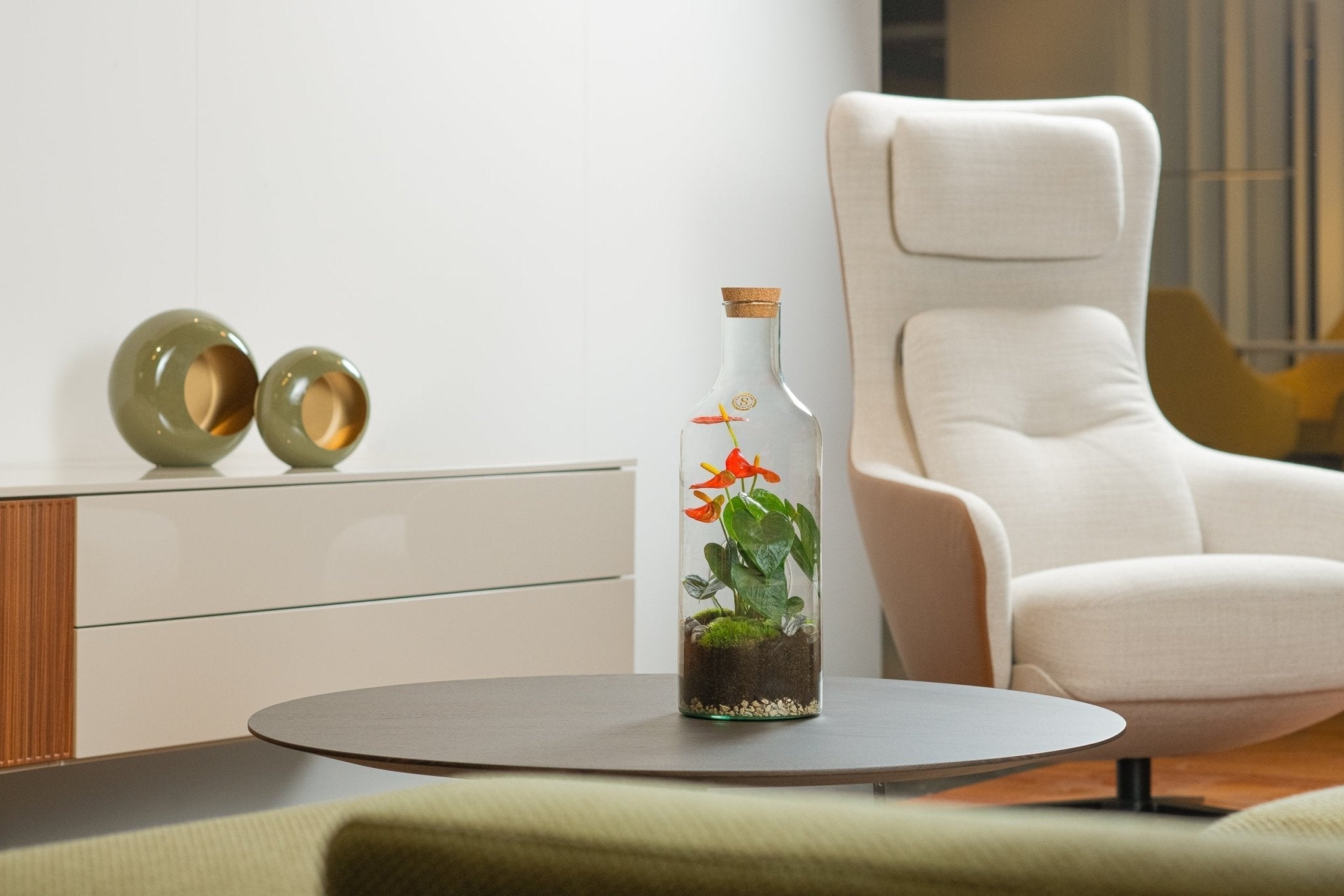Anthurium Care: Tips for a Healthy and Long-Lasting Flamingo Plant
The anthurium, also known as the flamingo flower, is a beautiful houseplant that blooms year-round. With its glossy leaves and striking flowers, it's a real eye-catcher in your home. In this guide, we share everything you need to know about caring for your anthurium, including how long an anthurium lasts, and the ideal spot for your anthurium. This way, you'll learn a lot about anthuriums and how to best care for them.
The Ideal Location for your Anthurium
-
Light: Place your Anthurium in a spot with plenty of indirect light . Direct sunlight can burn the leaves. A location with morning or evening sun is ideal.
-
Temperature: Keep the plant in a warm environment, preferably between 20-25°C . Avoid temperatures below 16°C .
-
Humidity: Anthuriums prefer high humidity (60-80%). Increase the humidity by using a humidifier or regularly misting the plant with water.

Watering your Anthurium
-
Frequency: Water the plant regularly, but ensure the soil remains slightly moist, not soaked. Water less frequently in winter. Let the top layer of the potting mix (about 2-3 cm) dry out before watering again.
-
Water quality: Preferably use rainwater or distilled water to prevent limescale deposits.
-
Hydroponics: Did you know you can also grow your Anthurium in water, without soil? All you need is a vase or glass jar with enough room for the roots. Make sure to change the water every two to three weeks.
Nutritional tips for a flowering Anthurium
-
Frequency: Feed the Anthurium once a month with liquid plant food, diluted to half strength. This is especially recommended during the growing season (spring and summer), but it's optional – your plant can thrive without additional feeding.
-
Type of nutrition: Use a balanced fertilizer for houseplants to avoid giving the plant too much or too little nutrients.

Maintenance and Care
-
Remove dead or yellowed leaves regularly to keep the plant healthy.
-
Support: As the plant grows larger, it may need some support. Use a stake to keep the stems upright.
-
Repotting: Repot your Anthurium every 2-3 years to give the roots enough space and keep the plant healthy.
How long does an Anthurium last?
-
Lifespan: A well cared for Anthurium can last 10 to 15 years or longer .
-
Flowering: The flowers themselves usually remain in bloom for 2 to 6 weeks , depending on care and variety.
-
Pruning: Regular pruning, sufficient light and the correct watering ensure a longer lifespan and a healthy plant.
The Most Common Anthurium Problems (and How to Fix Them)
Fortunately, most Anthurium problems can be easily solved with some attention and knowledge.
Yellow leaves
One of the most common anthurium problems is yellow leaves. This often indicates overwatering or insufficient light. To prevent this, allow the potting soil to dry out slightly and place your anthurium in a location with plenty of indirect light.
Brown leaf tips
Brown edges or leaf tips are another common problem with anthuriums. This is usually caused by dry air or too much fertilizer. Increase the humidity, for example, by placing a bowl of water next to the plant, and reduce the amount of fertilizer.
No more flowers
An anthurium that no longer blooms is a typical sign of improper care. This is one of the anthurium problems caused by too little light or too much nitrogen. Give the plant a brighter spot and use a fertilizer specifically formulated for flowering houseplants.
Brown or black spots
Black or brown spots on the leaves are often the result of too much sun or a fungal infection. You can solve these kinds of Anthurium problems by removing affected leaves and preventing water from accumulating on them.
Pests
Pests such as spider mites, thrips, and aphids are also common problems for Anthuriums. Rinse the leaves carefully and use an organic product like neem oil to combat the pests.
Most Anthurium problems are easily prevented with proper care: don't overwater, provide sufficient light, and maintain adequate humidity. This will keep your Anthurium healthy, shiny, and thriving.
Anthurium Facts
The Anthurium is not only one of the most beautiful houseplants, but also a real source of interesting facts.
Can an Anthurium cause headaches?
Yes and no. An Anthurium can cause headaches if you're allergic to the plant or sensitive to its compounds. However, the plant can actually help reduce headaches by purifying the air of harmful substances that can cause symptoms.
Is an Anthurium poisonous to cats and dogs?
Yes, the Anthurium is poisonous to pets. The plant contains calcium oxalate, a substance that causes burning pain and irritation in the mouth and throat if a cat or dog chews on it. Therefore, always keep the plant out of reach of pets – both the leaves and flowers are poisonous.
Can an Anthurium grow in water?
Absolutely! An anthurium thrives in water. This method—also called hydroponics—is not only aesthetically pleasing but also a modern and clean way to care for the plant.

Discover Our Anthurium Collection
At The Green Bottle Garden, you'll find an exclusive collection of anthurium houseplants , ready to enhance your interior. Our botanists are ready to advise you on care and placement.

Share:
Why does my plant have yellow leaves and how do you fix yellow leaves on your plant?
Bromeliad Care Tips | The Green Bottle Garden